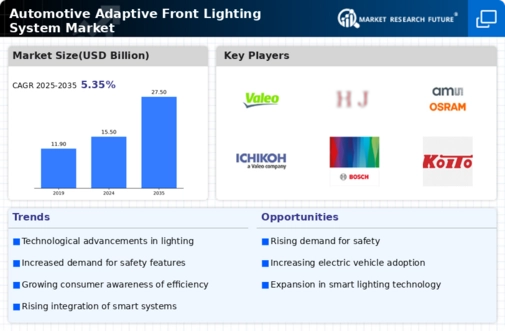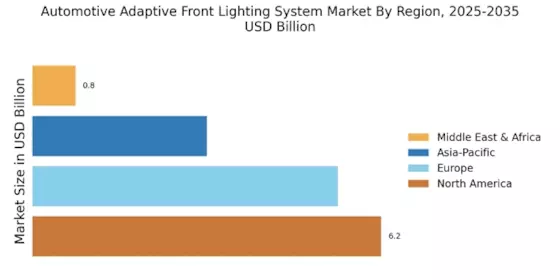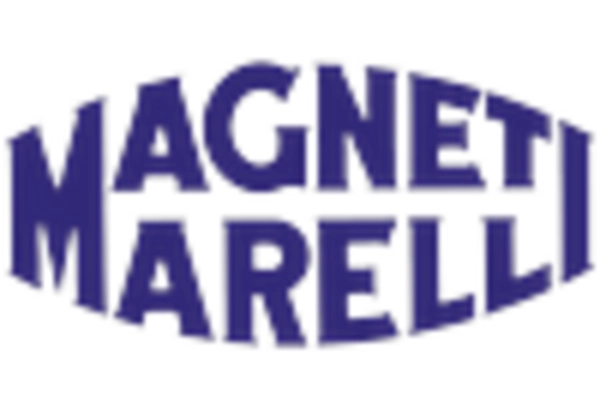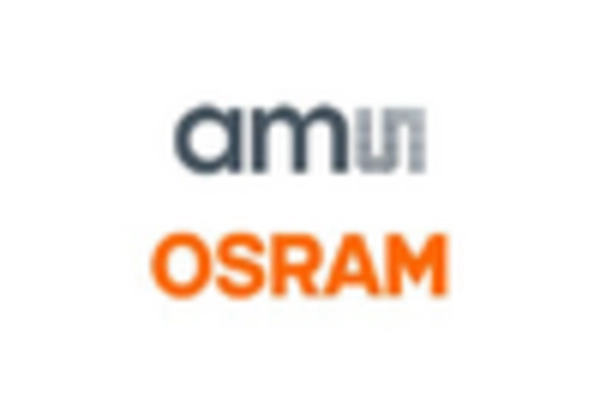Rising Awareness of Energy Efficiency
The Automotive Adaptive Front Lighting System Market is also influenced by the rising awareness of energy efficiency among consumers and manufacturers alike. As fuel economy becomes a critical consideration, the demand for energy-efficient lighting solutions is on the rise. Adaptive front lighting systems, particularly those utilizing LED technology, offer significant energy savings compared to traditional halogen lights. This shift not only contributes to lower fuel consumption but also aligns with broader environmental goals. Market data indicates that vehicles equipped with energy-efficient lighting systems are increasingly favored, suggesting a potential growth trajectory for the adaptive lighting market as sustainability becomes a priority for both consumers and manufacturers.
Regulatory Influences on Lighting Standards
Regulatory influences play a crucial role in shaping the Automotive Adaptive Front Lighting System Market. Governments worldwide are implementing stricter regulations regarding vehicle safety and lighting standards, which necessitate the adoption of advanced lighting technologies. These regulations aim to reduce accidents caused by poor visibility and to promote the use of adaptive lighting systems that adjust to varying driving conditions. As a result, manufacturers are compelled to innovate and comply with these standards, leading to increased investments in adaptive front lighting technologies. The market is likely to see a boost as compliance with these regulations becomes a key factor in vehicle design and production.
Consumer Demand for Enhanced Safety Features
Consumer preferences are shifting towards vehicles equipped with advanced safety features, driving growth in the Automotive Adaptive Front Lighting System Market. As awareness of road safety increases, consumers are more inclined to choose vehicles that offer superior visibility and adaptive lighting capabilities. This demand is reflected in market trends, where vehicles with adaptive front lighting systems are becoming more prevalent. According to recent data, nearly 30% of new vehicle models now incorporate these systems, indicating a strong consumer inclination towards safety-enhancing technologies. This trend is expected to continue, as consumers increasingly prioritize safety in their purchasing decisions, thereby propelling the market forward.
Technological Advancements in Lighting Systems
The Automotive Adaptive Front Lighting System Market is experiencing a surge in technological advancements, particularly in LED and laser lighting technologies. These innovations enhance visibility and improve road safety, which is increasingly prioritized by consumers. The integration of smart technologies, such as sensors and cameras, allows for dynamic adjustment of light patterns based on driving conditions. This adaptability not only improves nighttime driving experiences but also aligns with the growing trend towards automation in vehicles. As manufacturers invest in research and development, the market is projected to grow significantly, with estimates suggesting a compound annual growth rate of over 10% in the coming years. Such advancements are likely to redefine standards in the automotive lighting sector.
Integration with Autonomous Driving Technologies
The integration of Automotive Adaptive Front Lighting Systems with autonomous driving technologies is emerging as a pivotal driver in the market. As the automotive industry moves towards greater automation, the need for advanced lighting systems that can communicate with other vehicle systems becomes apparent. Adaptive lighting can enhance the functionality of autonomous vehicles by providing optimal illumination based on real-time data from sensors and navigation systems. This synergy not only improves safety but also enhances the overall driving experience. Market forecasts indicate that as the adoption of autonomous vehicles increases, the demand for sophisticated adaptive lighting solutions will likely follow suit, positioning the market for substantial growth in the near future.


















Leave a Comment